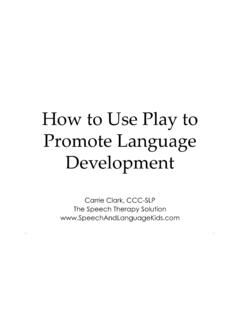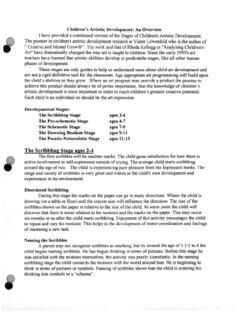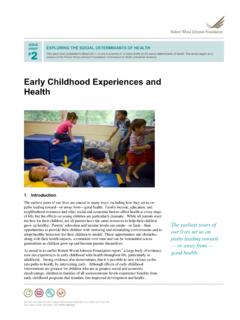Transcription of Brain Development and Early Learning - ed
1 1 Research on Brain DevelopmentFor decades researchers have been aware of the ex-traordinary Development of a child s Brain duringthe first five years of life. Recent advances in neuro-science have helped crystallize earlier findings, bringingnew clarity and understanding to the field of Early child-hood Brain Development . children are born ready tolearn. They cultivate 85 percentof their intellect, personalityand skills by age five. The firstmonths and years of life set thestage for lifelong of the importance ofearly Brain Development , whathappens in the Early years hasserious implications for publicpolicy that will be explored laterin this the neuroscience ofbrain Development unfolding,we now know that (1) the way abrain develops hinges on the complex interplay betweenthe genes a person is born with and the experiences aperson has from birth on; (2) it actually takes up to 12 yearsfor the Brain to become fully organized, with parts of thecortex still to become organized through the later teen years;(3) the quality of an infant s relationship with his or herprimary caregivers has a decisive impact on the architectureof the Brain , affecting the nature and extent of adult ca-pabilities; and (4) Early interactions directly affect the waythe Brain is wired, and do not merely create a context fordevelopment.
2 The human Brain develops more rapidly between birthand age five than during any other subsequent period. The 100 billion neurons that humans are born with makeconnections through synapses, wiring the Brain for ac-tion. The experiences an individual has impact the typesand amount of synaptic connections that are made. Synap-tic connections begin prior to birth and are created at arapid rate through age three. The Brain operates on a use itor lose it principle. Only those connections and pathwaysthat are activated frequently are retained. Other connec-tions that are not consistently used will be pruned or dis-carded so the active connections can become preschool years are the time in which the Brain beginsto maximize efficiency by determining which connectionsto keep and which to eliminate. Providing Repeated Positive Experiences is CriticalFor children s brains to become highly developed forlearning, repeated experiences are essential.
3 Connectionsbecome stronger and more efficient through repeated to children every day, for example, helpsstrengthen essential connections. Connections are alsomade stronger when children have daily opportunities todevelop both large- and small-muscle skills, have thechance to practice developing social skills, and interact di-rectly with their environment. It is vital to incorporate richlanguage into all of these activities, since exposure to richlanguage creates the foundation for a child s use and un-derstanding of words, and increases the likelihood of read-ing success at a later age. Research shows that the richness of a young child s ver-bal interactions has a dramatic effect on vocabulary andschool readiness, with differences correlated to socio-eco-nomic status. A watershed study on the topic found thatby age 3, the observed cumulative vocabulary for childrenin professional families was 1,116 words; for working classfamilies it was about 740, and for welfare families 525.
4 Quality Matters: A Policy Brief Series on Early Care and Education Winter 2007 Volume 1 Brain Development and Early Learningcontinued on page 2 Brainstem regulates blood pressure,heart rate, and body temperatureMidbrain motor regulation and sleepLimbic attachment, sexual behavior,emotional reactivityCortex abstract and concrete thoughtBasics of Brain StructureThe Brain grows in sequential fashion, from bottom(brainstem) to top (cortex), or from the least complexfunctioning to the most complex. By age three, 85 percentof the core structures of the Brain are formed. The characteristics of Learning readiness aredeveloped rather than taught and only throughnumerous concrete interactions with the world cana young child prepare to benefit from formalinstruction later. David Elkind, noted author on child developmentTo develop the higher areas of the Brain , children mustbe able to experience things for themselves and feel thesense of accomplishment that goes along with completingtasks independently.
5 To support this, adults need to allow(not force) enough time for children to try things over andover again. In this way, the Brain is reassured that what islearned is true. However, children need someone availableto help and encourage them when things get overwhelm-ing, and to support them in new situations. children feelcomfortable and develop a continued sense of excitementtoward Learning when caring adults provide structure andappropriate stimulation. The brains of preschoolers are working to create or-ganization through consistency. It is essential that rou-tines and limits for preschool children be established andare adhered to. Preschool children s brains have a lot ofplasticity and also vulnerability to their environment, andwill therefore continually adapt to what they are exposedto. Environments that are chaotic, disorderly or highlystressful have a direct negative influence on the develop-ment of the cortex. A child does not learn from a passive kaleidoscopeof experiences but from the outcomes of actionsthat he or she has initiated.
6 John Keith Brierley, author of Give Me a ChildUntil He Is Seven: Brain Studies and EarlyChildhood EducationEarly Learning Programs Impact the Developing Brain Early Learning programs that are appropriate for a child sdevelopmental level provide opportunities to learn throughplay and hands-on exploration. Through this type oflearning, children test new knowledge in a relaxed settingand then naturally relate it to existing knowledge and storethe new information. Learning progress may actually be slowed by overlyacademic preschool experiences that introduce formalized Learning experiences too Early for a child s developmental status. Rebecca Marcon, Developmental Psychologist According to Jane Healy, a well-respected educational psy-chologist, Early childhood programs that implement a di-rected academic curriculum often replace essential,hands-on Learning activities with skill-based performanceand rote- Learning tasks.
7 In doing so, they risk the devel-opmental growth necessary for children s future academicsuccess. iiiExperts believe that when rote- Learning tasksare used extensively in an Early childhood classroom orother setting, normal growth and Development of thebrain can become distorted. 2 Quality Matters: A Policy Brief Series on Early Care and Education Wisconsin Council on children and FamiliesBrain Development : The Early YearsThrough increased understanding of Brain Development ,we know what young children need most. Whether athome or in a formal Early education setting, children willdevelop best if they are provided with: Positive, reliable and supportive relationships Regular routines and consistency Chances to repeat activities Opportunities to learn through hands-on interaction Exposure to rich, interactive language Novel ways to learnPublic Policy ImplicationsWhat does this research on Early childhood braindevelopment mean for public policy?
8 To whatextent should states and communities takepublic action to improve Early Learning ? Should families beexpected to manage on their own? These questions haveprovided the basis for growing public debate about invest-ments in Early care and education. Profound Societal ChangesAfter reviewing a quarter century of research, scholarsconvened by the National Research Council concludedthat profound social and economic transformations areposing serious challenges to the efforts of parents and othersto ensure proper Early childhood These changing conditions include: The remarkable growth in the number of workingmothers with young children . In 2004, 66 percent(approximately 267,000) of all children under six inWisconsin had all parents in the labor force, one ofthe highest percentages in the The rise in divorce and in poor single-parent fami-lies. Wisconsin s divorce rate has doubled over thelast 30 years, and nearly one quarter of children livein single-parent appears that many of Wisconsin s parents are strug-gling in their efforts to assure that their children are safe,healthy, and prepared for school.
9 Most developed coun-tries far surpass the United States in their Early care andeducation of Benefits of High QualityEarly Care and EducationMounting evidence indicates that effective, well-plannedearly care and education programs can positively supple-ment parents efforts, and have dramatic positive impactson children s school success. This success carries over intotheir adult lives. The policy issue is not one of getting children readyto learn , but rather one of appreciating that they areborn to learn and crafting policies and programs thatactively build on their considerable capabilities. National Research Council, 2000 According to James Heckman, University of ChicagoEconomist and Nobel Laureate, investments in high-qualityearly education programs have the highest rate of return ofany social Committee for Economic De-velopment, an independent,nonpartisan think tank, con-cluded that high quality pre-school programs offer societalbenefits that far outweigh pro-gram costs by improving thelater education, employment,earnings and crime outcomes ofstudents who attend strong body of research indi-cates that investing in rich learn-ing experiences for low-incomechildren produces particularlyhigh returns, while new researchshows encouraging impacts onmiddle-class children with ex-posure to well-designed pre-school programs.
10 Some argue that investmentsin Early care and education arewiser than those made at anyother age. The graph below il-lustrates the trajectory of braindevelopment compared to publicinvestment, by age. It is strikingthat while 85 percent of a child s3continued on page 4 Wisconsin Council on children and FamiliesBrain Development : The Early Yearscore Brain structure is formed by age five, less than 4 per-cent of public investments on education and developmenthave occurred by that factors combine to present a strong case for anew public policy that invests more in young children s de-velopment and education: the growing body of researchof the importance of the first five years in Brain develop-ment and school readiness; the changing pressures on Wis-consin s families; and the promising evidence of the positivelong-term effects from investing in Early Learning pro-grams. The research and experience of the last quartercentury logically lead to a call for Wisconsin to review itscurrent investments in Early education and to design amore coherent system of Early care and education more information on specific policy changes, go Research Council and Institute of , FromNeurons to Neighborhoods: The Science of Early Childhood Develop-ment.


















